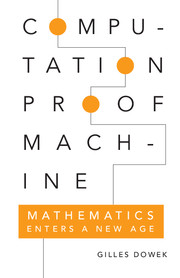Refine search
Actions for selected content:
1669 results in Computing: general interest
Contents
-
- Book:
- Computation, Proof, Machine
- Published online:
- 05 May 2015
- Print publication:
- 05 May 2015, pp vii-viii
-
- Chapter
- Export citation
Dedication
-
- Book:
- Computation, Proof, Machine
- Published online:
- 05 May 2015
- Print publication:
- 05 May 2015, pp v-vi
-
- Chapter
- Export citation
8 - Constructive Proofs and Algorithms
- from PART TWO - The Age of Reason
-
- Book:
- Computation, Proof, Machine
- Published online:
- 05 May 2015
- Print publication:
- 05 May 2015, pp 82-86
-
- Chapter
- Export citation
1 - The Prehistory of Mathematics and the Greek Resolution
- from PART ONE - Ancient Origins
-
- Book:
- Computation, Proof, Machine
- Published online:
- 05 May 2015
- Print publication:
- 05 May 2015, pp 5-14
-
- Chapter
- Export citation

Computation, Proof, Machine
- Mathematics Enters a New Age
-
- Published online:
- 05 May 2015
- Print publication:
- 05 May 2015
11 - Proof Checking
- from Part Three - Crisis of the Axiomatic Method
-
- Book:
- Computation, Proof, Machine
- Published online:
- 05 May 2015
- Print publication:
- 05 May 2015, pp 105-110
-
- Chapter
- Export citation
4 - From the Decision Problem to Church's Theorem
- from PART TWO - The Age of Reason
-
- Book:
- Computation, Proof, Machine
- Published online:
- 05 May 2015
- Print publication:
- 05 May 2015, pp 44-54
-
- Chapter
- Export citation
13 - Instruments
- from Part Three - Crisis of the Axiomatic Method
-
- Book:
- Computation, Proof, Machine
- Published online:
- 05 May 2015
- Print publication:
- 05 May 2015, pp 124-133
-
- Chapter
- Export citation
Biographical Landmarks
-
- Book:
- Computation, Proof, Machine
- Published online:
- 05 May 2015
- Print publication:
- 05 May 2015, pp 139-148
-
- Chapter
- Export citation
7 - Constructivity
- from PART TWO - The Age of Reason
-
- Book:
- Computation, Proof, Machine
- Published online:
- 05 May 2015
- Print publication:
- 05 May 2015, pp 73-81
-
- Chapter
- Export citation
10 - Automated Theorem Proving
- from Part Three - Crisis of the Axiomatic Method
-
- Book:
- Computation, Proof, Machine
- Published online:
- 05 May 2015
- Print publication:
- 05 May 2015, pp 96-104
-
- Chapter
- Export citation
Notes
-
- Book:
- The Computing Universe
- Published online:
- 05 December 2014
- Print publication:
- 08 December 2014, pp 367-376
-
- Chapter
- Export citation
A quick tour through the book
-
- Book:
- The Computing Universe
- Published online:
- 05 December 2014
- Print publication:
- 08 December 2014, pp xi-xii
-
- Chapter
- Export citation
Prologue: Blog entry from Jonathan Hey
-
- Book:
- The Computing Universe
- Published online:
- 05 December 2014
- Print publication:
- 08 December 2014, pp xv-xvi
-
- Chapter
- Export citation
Acknowledgments
-
- Book:
- The Computing Universe
- Published online:
- 05 December 2014
- Print publication:
- 08 December 2014, pp xiii-xiv
-
- Chapter
- Export citation
General index
-
- Book:
- The Computing Universe
- Published online:
- 05 December 2014
- Print publication:
- 08 December 2014, pp 393-397
-
- Chapter
- Export citation
7 - Moore’s law and the silicon revolution
-
- Book:
- The Computing Universe
- Published online:
- 05 December 2014
- Print publication:
- 08 December 2014, pp 120-140
-
- Chapter
- Export citation
2 - The hardware
-
- Book:
- The Computing Universe
- Published online:
- 05 December 2014
- Print publication:
- 08 December 2014, pp 23-38
-
- Chapter
- Export citation
14 - Machine learning and natural language processing
-
- Book:
- The Computing Universe
- Published online:
- 05 December 2014
- Print publication:
- 08 December 2014, pp 280-297
-
- Chapter
- Export citation
Figure credits
-
- Book:
- The Computing Universe
- Published online:
- 05 December 2014
- Print publication:
- 08 December 2014, pp 381-388
-
- Chapter
- Export citation
